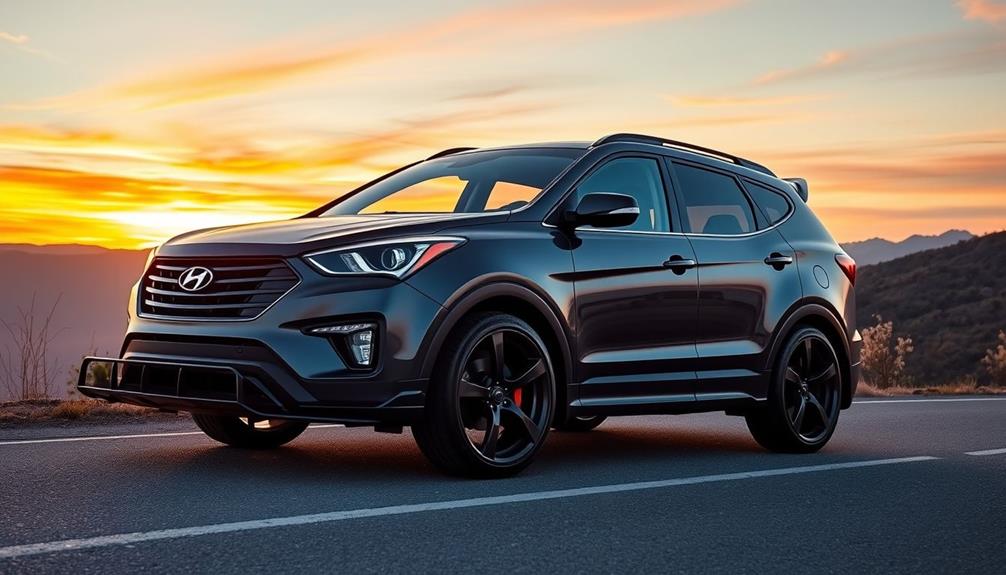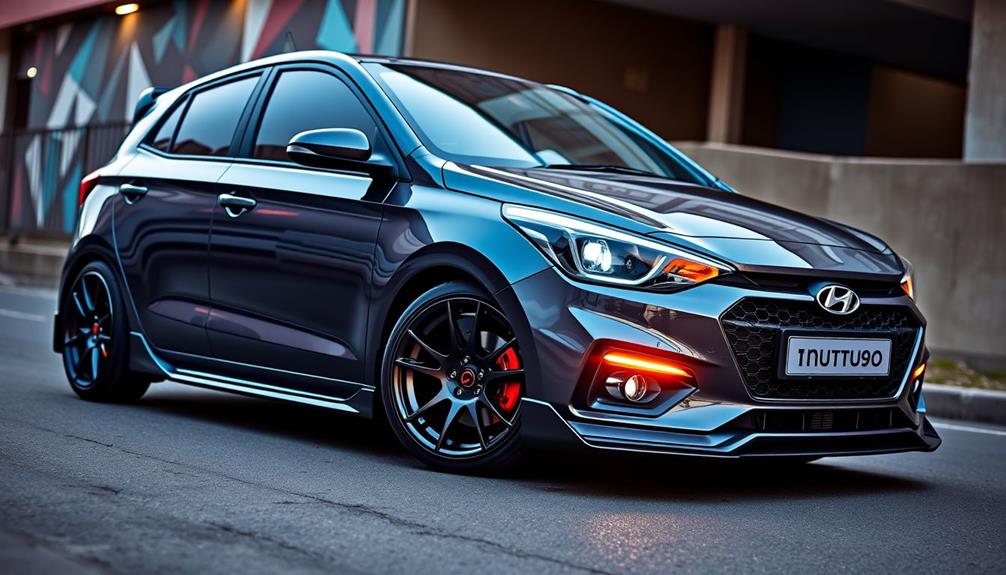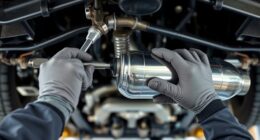Tuning your Hyundai Santa Fe can transform it into a performance machine. By adjusting the engine's ECU maps, you can boost horsepower by about 10 when using 91 octane fuel, especially in turbocharged models. This enhancement improves acceleration and throttle response, making every drive more exciting. Just remember, premium fuel is essential for maximizing those gains, and you might notice a slight increase in fuel consumption. Always consider the potential risks, like warranty voids or engine issues, when tuning. If you're keen to maximize your Santa Fe's potential, there's more to explore on performance upgrades and community insights.
Key Takeaways
- Tuning can increase engine performance by approximately 10 horsepower, especially with 91 octane fuel, enhancing overall driving experience.
- Improved throttle response and reduced turbo lag in turbocharged models make for a more exhilarating drive post-tuning.
- Utilizing premium 91 octane fuel is crucial for maximizing the benefits of tuning and preventing performance degradation.
- Upgrading components like intake systems and exhausts further boosts performance, particularly in turbocharged Santa Fe models.
- Engaging with the Hyundai community provides valuable insights and experiences to guide your tuning journey effectively.
Benefits of Tuning Your Santa Fe
When you tune your Hyundai Santa Fe, you activate a range of impressive benefits that can elevate your driving experience. One of the most significant advantages is the enhanced engine performance. By utilizing chip tuning, you could see an increase of about 10 horsepower, especially when you use 91 octane fuel. This boost translates to improved acceleration and throttle response, making every drive more enjoyable.
In addition to power gains, tuning can also enhance your vehicle's overall performance, particularly in turbocharged models. Many users report noticeable differences after modifications, leading to a more engaging driving experience.
However, it's vital to recognize that while you may enjoy these performance improvements, tuning can increase fuel consumption and reduce your range per tank.
Integrating aftermarket components, such as intake systems, can further amplify your Santa Fe's performance, with some users achieving impressive boosts up to 20 psi.
Just remember to weigh the benefits against potential trade-offs, like warranty voids and increased maintenance. Ultimately, tuning can transform your Santa Fe into a performance machine, but it's crucial to reflect on how these changes align with your long-term driving goals.
Understanding Chip Tuning
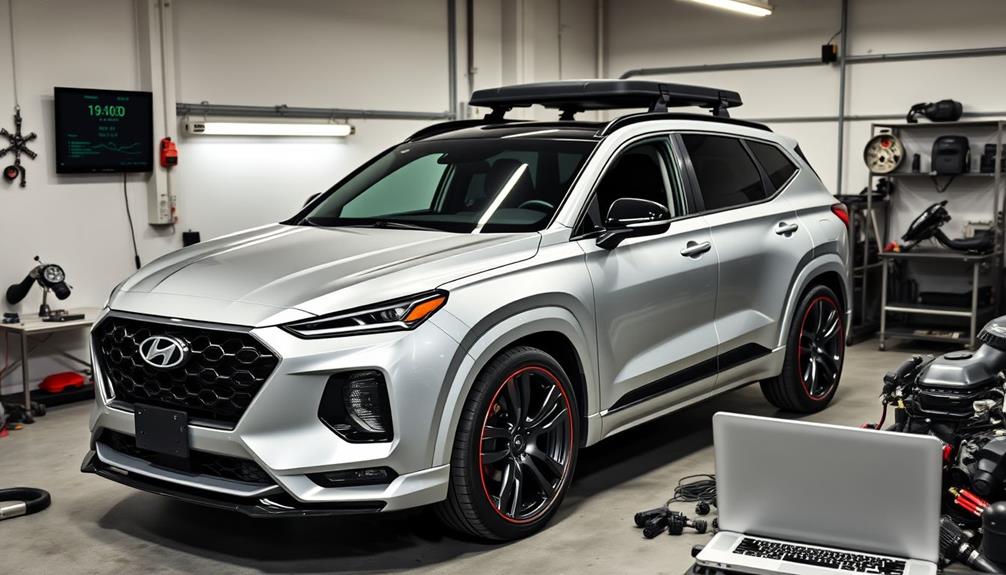
When it comes to chip tuning, you can release significant performance benefits for your Hyundai Santa Fe, especially with the right fuel quality.
However, it's important to understand that while tuning can enhance your vehicle's power and responsiveness, it also carries risks if not done correctly.
You'll want to weigh these factors carefully to guarantee you're making a reliable upgrade.
Benefits of Chip Tuning
Chip tuning can greatly enhance your Hyundai Santa Fe's performance by adjusting the engine's ECU maps. This modification typically results in an increase of around 10 horsepower when you use 91 octane fuel, making your powerful engine even more responsive.
For turbocharged models, chip tuning considerably reduces turbo lag, improving throttle response and acceleration. You'll enjoy a more dynamic driving experience as your SUV becomes livelier on the road.
However, it's important to mention that performance gains can vary based on fuel quality. If you stick to lower octane fuel like 87, you may see minimal improvements.
While chip tuning can help you access your vehicle's potential, it may also lead to increased fuel consumption, so keep an eye on your range per tank.
Additionally, consider that chip tuning might void your warranty and could increase wear on the engine components. As a result, it's vital to weigh the benefits against the potential downsides.
If you're ready to transform your family SUV into a performance machine, chip tuning could be the perfect upgrade for you. Just make sure to choose your tuning options wisely.
Fuel Quality Impact
Understanding the impact of fuel quality is fundamental for maximizing the benefits of chip tuning on your Hyundai Santa Fe. When you invest in chip tuning, you can access significant performance gains, often around 10 HP, particularly when using 91 octane fuel. This premium fuel enhances the modified ECU maps, allowing your SUV to perform at its best.
However, if you opt for lower octane fuels like 87, you mightn't see the same improvements. In fact, using subpar fuel can result in reduced overall performance, negating the advantages of your tuning investment.
It's essential to take into account that while tuning can improve performance, it may also lead to increased fuel consumption, which can diminish your fuel economy and reduce the range per tank.
To truly benefit from your tuning efforts, always monitor the type of fuel you use post-tuning. By sticking with high-quality fuel, you'll guarantee you're getting the most out of your enhancements while mitigating any potential pitfalls.
In short, fuel quality plays a significant role in the overall performance and efficiency of your tuned Hyundai Santa Fe.
Risks and Reliability
Before diving into chip tuning your Hyundai Santa Fe, it's vital to take into account the associated risks and reliability issues. While the promise of enhanced performance is enticing, modifying your vehicle's ECU can void existing warranties, leaving you responsible for potentially costly repairs if something goes wrong.
Incorrectly executed tuning poses significant risks, including engine failures, which underscores the need for professional installation and expertise. Even if the tuning is done correctly, the increased performance can lead to more wear and tear on engine components, requiring more frequent maintenance and potentially higher long-term costs.
Additionally, consider the insurance implications; some companies may raise premiums or deny claims related to tuning-related failures. This means you should carefully weigh the trade-offs between performance gains and reliability concerns.
Ultimately, while chip tuning can transform your Santa Fe into a performance machine, it's important to understand that these modifications come with risks that could impact your vehicle's reliability and your wallet.
Make informed decisions to guarantee you enjoy your enhanced driving experience without unforeseen consequences.
Fuel Quality Considerations
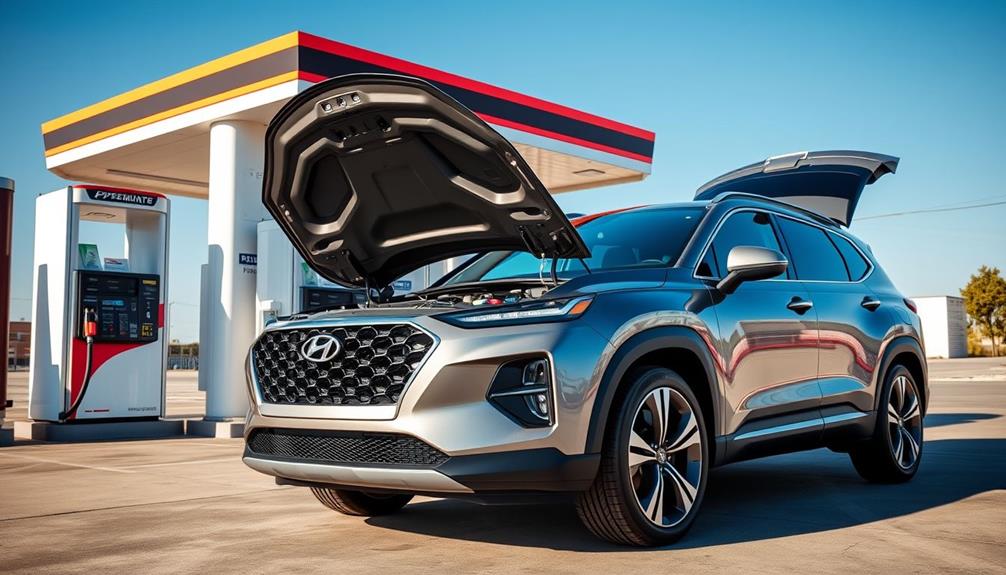
When tuning your Hyundai Santa Fe, you'll need to contemplate the importance of using premium fuel, especially if you have a turbocharged model.
Opting for higher octane ratings not only boosts performance but also prevents potential engine knocking that can occur with lower octane fuels.
Keep in mind that the long-term cost of premium fuel can add up, so it's wise to factor that into your overall expenses.
Premium Fuel Requirements
For ideal performance in your Hyundai Santa Fe, using premium fuel, particularly 91 octane, is vital after tuning. This higher octane rating helps you achieve the performance enhancements you've invested in, preventing engine knocking that can occur with lower octane fuels like 87.
If you opt for regular fuel, you may find the minimal performance benefits can negate the advantages gained from your tuning modifications.
While premium fuel can be more expensive, the cost differential can considerably impact your overall expenses. If you're serious about maximizing your Santa Fe's capabilities, prioritizing premium fuel is a must.
However, be aware that users of tuned models often report increased fuel consumption, leading to a reduced driving range per tank.
Regularly monitoring your fuel type and consumption is essential after tuning. This not only guarantees your vehicle operates efficiently but also helps maintain the performance gains you expect.
Octane Rating Impact
A higher octane rating can greatly impact your Hyundai Santa Fe's performance, especially after tuning. When you use premium fuel, such as 91 octane, you can release significant performance gains from your tuning modifications. For instance, you could see an increase of around 10 horsepower, translating to a more exhilarating driving experience.
On the flip side, if you opt for lower octane fuel like 87, you might find that the benefits of tuning diminish. Not only will the performance be less impressive, but it can also lead to reduced overall efficiency in tuned engines. This means you might experience increased fuel consumption, ultimately leading to a shorter range per tank.
To guarantee that you get the most out of your upgrades, it's essential to monitor your fuel type and consumption regularly. Using the right octane rating is key to maintaining peak performance and reliability after tuning.
Long-Term Cost Implications
Fuel quality plays a significant role in the long-term cost implications of tuning your Hyundai Santa Fe. When you tune your SUV, especially with a turbocharged engine, it's crucial to use premium fuel (91 octane) to achieve the best performance enhancements and prevent engine knocking.
If you opt for lower octane fuel, like 87, you might notice minimal performance gains, which highlights how vital fuel quality is for maximizing your investment in tuning.
The cost difference between regular and premium fuel can add up quickly, impacting your monthly expenses. Not only will you be spending more at the pump, but tuned engines often experience higher fuel consumption, which can reduce your driving range per tank.
This means you'll find yourself refueling more frequently, further compounding those long-term costs.
To maintain peak performance and avoid potential engine damage, you should regularly monitor your fuel type and consumption.
Risks of Performance Modifications
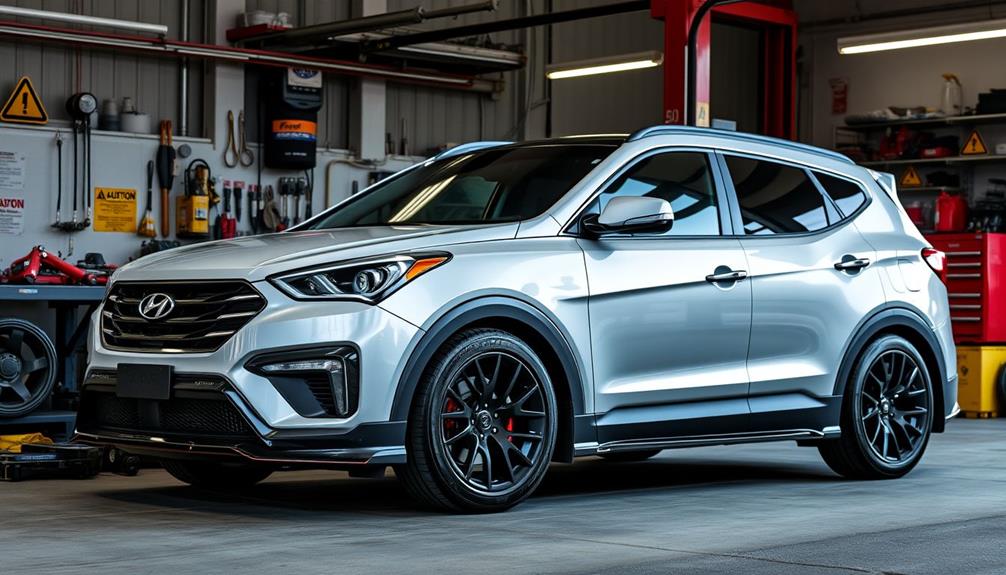
Many enthusiasts underestimate the risks associated with performance modifications on their Hyundai Santa Fe. While enhancing engine performance might seem appealing, it can lead to significant issues.
For instance, chip tuning can void your manufacturer's warranty, leaving you responsible for all repairs if anything goes wrong.
Moreover, increasing engine performance often results in higher wear and tear on essential components, which could lead to costly repairs or even early engine failure. You might also find that many insurance policies don't cover damages caused by performance modifications, putting you at financial risk if an accident occurs.
Additionally, engine tuning tends to elevate the maintenance needs of your vehicle. You'll likely face more frequent servicing and higher overall costs compared to stock models, which can strain your budget over time.
Engine Upgrades for Power
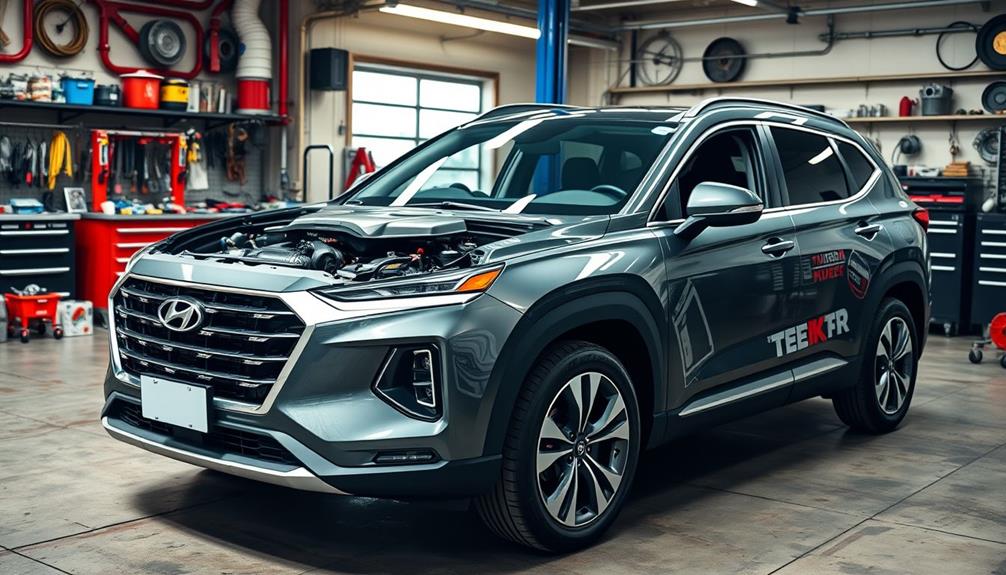
When you upgrade your Hyundai Santa Fe's engine, you'll release the true potential of its turbocharged 2.5-liter engine.
Adding aftermarket parts like intake systems can greatly boost your performance, pushing your Santa Fe's capabilities even further.
To maximize your gains, consider the right upgrades and always opt for higher octane fuel.
Turbocharged Engine Benefits
Upgrading your Hyundai Santa Fe's turbocharged engine can release a range of performance benefits that enhance both power and driving experience. With the 2.5-liter turbocharged engine producing 277 horsepower and 311 lb-ft of torque, you're starting with a solid foundation for performance upgrades.
One of the simplest ways to boost output is through chip tuning. By using 91 octane fuel, you can gain about 10 additional horsepower, which greatly improves throttle response and acceleration.
Moreover, investing in high-performance intake systems can further optimize your engine's efficiency. Some users report achieving boost levels of up to 20 psi, allowing for even better power delivery.
It's vital to remember that tuning performance is highly dependent on fuel quality; using lower octane fuel, like 87, won't yield the same results and may reduce overall performance.
These upgrades not only enhance the driving experience but can also increase your Santa Fe's towing capacity to 4,500 lbs. This means you can confidently tackle family trips or transport heavy loads without compromising on performance.
Embracing these turbocharged engine benefits transforms your family SUV into a capable performance machine.
Aftermarket Part Recommendations
To access the full potential of your Hyundai Santa Fe's turbocharged engine, consider incorporating a selection of carefully chosen aftermarket parts.
These upgrades can enhance performance, power, and overall driving experience. Here's a list of recommended modifications:
- Upgrading the Intake System: Boost airflow to your engine for increased horsepower and improved throttle response, especially when paired with chip tuning.
- Performance Exhaust System: Install a performance exhaust system to reduce backpressure, allowing for efficient exhaust flow, which can enhance horsepower and deliver a more aggressive sound.
- Engine Management System: Utilize a quality engine management system and tuning software to refine fuel maps and ignition timing, maximizing the performance gains from your other upgrades.
- High-Performance Intercooler: If you're pushing your turbocharged engine, a high-performance intercooler can help maintain ideal intake temperatures, leading to improved power and reliability.
Suspension Enhancements for Handling

Enhancing your Hyundai Santa Fe's suspension can greatly improve handling, making every drive more enjoyable and responsive. By upgrading the suspension system, you can replace factory components with performance-oriented shocks and struts, which will boost road grip and responsiveness during cornering. This means you'll tackle sharp turns with confidence.
Consider utilizing coilover kits for adjustable ride height and damping settings. This flexibility allows you to fine-tune your suspension for comfort or performance, especially on varied terrains.
To further enhance stability, install performance sway bars. They'll reduce body roll during sharp turns, making your Santa Fe feel more agile on the road.
Additionally, installing heavier-duty bushings can improve suspension feedback and longevity. This guarantees your vehicle maintains precise alignment and reduces deflection during aggressive driving.
If you enjoy off-roading, upgraded suspension components can considerably enhance your Santa Fe's off-road capabilities, providing better articulation and ground clearance to tackle rugged trails.
With these suspension enhancements, your Hyundai Santa Fe will transform from a family SUV into a performance machine that handles with precision and confidence.
Aesthetic Modifications and Customization

When it comes to making your Hyundai Santa Fe stand out, aesthetic modifications can transform its appearance and reflect your personal style.
From striking paint jobs to stylish accessories, enhancing your SUV is all about expressing who you are. Here are some ideas to evaluate:
- Custom Paint Options: Explore colors like Abyss Black Pearl or Ocado Green Pearl to give your Santa Fe a unique flair.
- Distinctive Alloy Wheels: Upgrade to eye-catching alloy wheels that complement your vehicle's robust stance, enhancing its sporty look.
- LED Lighting Upgrades: Implement sleek LED lights to modernize the exterior, giving your SUV a stylish glow, especially at night.
- Interior Customization: Choose high-quality materials for the interior, creating a luxurious and personalized driving experience.
These aesthetic modifications not only boost your Santa Fe's visual appeal but also make it a reflection of your individuality.
With the right touches, you'll turn heads wherever you go!
Community Insights and Recommendations

Engaging with the Hyundai Santa Fe community can provide invaluable insights and recommendations for tuning your vehicle. With forums boasting over 1.8 million posts and 426.5k members, you'll find a treasure trove of advice on enhancing your Santa Fe XRT's performance. Chip tuning, for instance, has been particularly praised for boosting horsepower and throttle response, especially when using 91 octane fuel.
Here's a quick overview of community insights regarding tuning:
| Tuning Aspect | Community Feedback | Considerations |
|---|---|---|
| Performance Gains | Significant improvements noted | Fuel quality matters |
| Aftermarket Options | Limited but growing interest | Compatibility varies |
| Professional Advice | Highly recommended | Reliability concerns |
Cost Implications of Tuning

Tuning your Hyundai Santa Fe can yield impressive performance gains, but it's essential to analyze the associated costs. Understanding the cost implications helps you make informed decisions about modifications. Here's what you should consider:
- Tuning Service Costs: Professional tuning services can range from $300 to $1,000. The price varies based on the complexity of the modifications and the shop's expertise.
- Fuel Expenses: Chip tuning often requires premium fuel, increasing your fuel costs by approximately 20-30 cents per gallon compared to regular fuel. This can add up over time.
- Increased Fuel Consumption: While you may gain performance, tuning can lead to higher fuel consumption, potentially reducing your vehicle's range per tank. Factor this into your budget.
- Warranty Considerations: Modifications like chip tuning can void existing warranties. This could lead to unexpected repair costs in the future, which you should take into account when evaluating overall expenses.
Future of Santa Fe Tuning

The future of tuning for the Hyundai Santa Fe looks promising as interest in performance enhancements continues to grow, especially for the popular 2.0T and 2.5T engine variants.
With the robust community engagement on platforms like Hyundai Forums, where over 1.8 million posts highlight tuning discussions, it's clear that you're not alone in seeking out these upgrades. Manufacturers and tuners are likely to respond to this demand by expanding aftermarket options, including chip tuning, intake upgrades, and exhaust enhancements.
Moreover, the potential for performance enhancement in hybrid and plug-in hybrid models remains largely untapped.
As eco-conscious drivers look for ways to boost their vehicle's capabilities, expect innovative aftermarket solutions to emerge, allowing you to maximize efficiency without sacrificing power.
Ongoing advancements in automotive technology will also play a significant role in shaping the future of Santa Fe tuning.
Staying informed about the latest trends and best practices in the tuning community will be essential for you to guarantee the reliability and performance of your modified Santa Fe.
Embrace these changes, and you'll be part of a growing movement that transforms family SUVs into performance machines.
Frequently Asked Questions
Can You Tune a Hyundai Santa Fe?
Yes, you can tune a Hyundai Santa Fe, especially turbocharged models. By modifying ECU maps, you'll enhance performance, but be cautious; it might void your warranty and could cause increased wear on engine components.
Can You Chip a Hyundai Santa Fe?
Can you chip a Hyundai Santa Fe? Absolutely! By modifying the ECU, you can boost performance. Just remember, careful research and consideration are essential to avoid potential warranty issues and guarantee compatibility with your vehicle.
How Much Horsepower Does a 2024 Hyundai Santa Fe 2.5 Turbo Have?
The 2024 Hyundai Santa Fe 2.5 Turbo packs a punch with 277 horsepower and 311 lb-ft of torque. You'll appreciate its enhanced acceleration, making it perfect for various driving needs and towing capabilities.
What Does XRT Mean on a Hyundai?
The "XRT" on a Hyundai signifies a trim designed for off-road adventures. It features enhanced ground clearance, rugged elements, and improved performance, perfect for tackling tough terrains and making your driving experience more exciting.
Conclusion
In the journey of transforming your Hyundai Santa Fe, think of tuning as the key that reveals hidden potential. Like a caterpillar becoming a butterfly, your family SUV can evolve into a thrilling performance machine. Embrace the risks and rewards, and don't shy away from community insights. With each modification, you're not just enhancing your ride; you're crafting a unique expression of yourself. So, take the leap and watch your Santa Fe soar to new heights! Consider seeking out professional assistance for highperformance Hyundai Tucson tuning to ensure that each modification is executed with precision and expertise. With the right team behind you, your Santa Fe will become a true standout on the road, attracting attention and admiration from fellow enthusiasts. So, don’t hesitate to explore the world of tuning and unlocking the full potential of your Hyundai Santa Fe.
